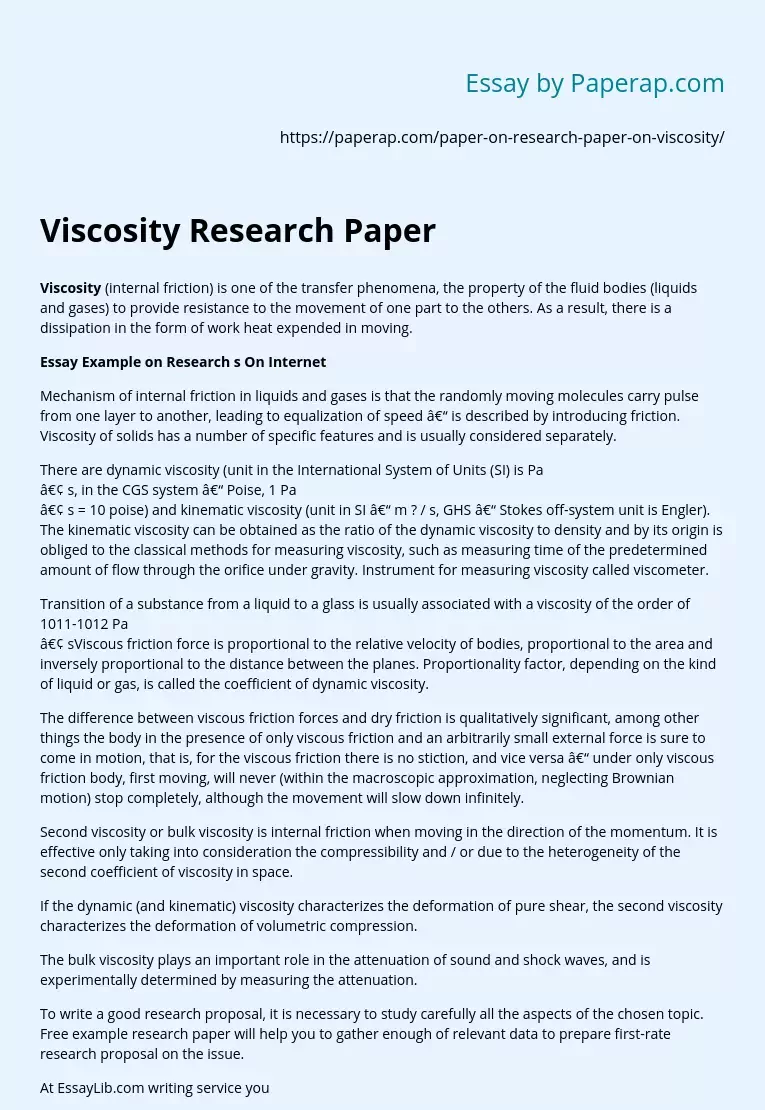Viscosity Research Paper
Viscosity (internal friction) is one of the transfer phenomena, the property of the fluid bodies (liquids and gases) to provide resistance to the movement of one part to the others. As a result, there is a dissipation in the form of work heat expended in moving.
Essay Example on Research s On Internet
Mechanism of internal friction in liquids and gases is that the randomly moving molecules carry pulse from one layer to another, leading to equalization of speed – is described by introducing friction.
Viscosity of solids has a number of specific features and is usually considered separately.
There are dynamic viscosity (unit in the International System of Units (SI) is Pa
• s, in the CGS system – Poise, 1 Pa
• s = 10 poise) and kinematic viscosity (unit in SI – m ? / s, GHS – Stokes off-system unit is Engler). The kinematic viscosity can be obtained as the ratio of the dynamic viscosity to density and by its origin is obliged to the classical methods for measuring viscosity, such as measuring time of the predetermined amount of flow through the orifice under gravity.
Instrument for measuring viscosity called viscometer.
Transition of a substance from a liquid to a glass is usually associated with a viscosity of the order of 1011-1012 Pa
• sViscous friction force is proportional to the relative velocity of bodies, proportional to the area and inversely proportional to the distance between the planes. Proportionality factor, depending on the kind of liquid or gas, is called the coefficient of dynamic viscosity.
The difference between viscous friction forces and dry friction is qualitatively significant, among other things the body in the presence of only viscous friction and an arbitrarily small external force is sure to come in motion, that is, for the viscous friction there is no stiction, and vice versa – under only viscous friction body, first moving, will never (within the macroscopic approximation, neglecting Brownian motion) stop completely, although the movement will slow down infinitely.
Second viscosity or bulk viscosity is internal friction when moving in the direction of the momentum. It is effective only taking into consideration the compressibility and / or due to the heterogeneity of the second coefficient of viscosity in space.
If the dynamic (and kinematic) viscosity characterizes the deformation of pure shear, the second viscosity characterizes the deformation of volumetric compression.
The bulk viscosity plays an important role in the attenuation of sound and shock waves, and is experimentally determined by measuring the attenuation.
To write a good research proposal, it is necessary to study carefully all the aspects of the chosen topic. Free example research paper will help you to gather enough of relevant data to prepare first-rate research proposal on the issue.
At EssayLib.com writing service you can order a custom research paper on Viscosity topics. Your research paper will be written from scratch. We hire top-rated Ph.D. and Master’s writers only to provide students with professional research paper assistance at affordable rates. Each customer will get a non-plagiarized paper with timely delivery. Just visit our website and fill in the order form with all research paper details:
Enjoy our professional research paper writing service!
Viscosity Research Paper. (2019, Nov 27). Retrieved from https://paperap.com/paper-on-research-paper-on-viscosity/

